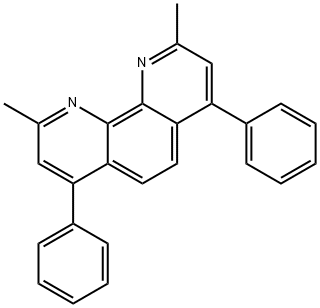Bathocuproine , 98% , 4733-39-5
Synonym(s):
2,9-Dimethyl-4,7-diphenyl-1,10-phenanthroline;BCP
CAS NO.:4733-39-5
Empirical Formula: C26H20N2
Molecular Weight: 360.45
MDL number: MFCD00004972
EINECS: 225-240-5
| Pack Size | Price | Stock | Quantity |
| 1G | RMB103.20 | In Stock |
|
| 5G | RMB399.20 | In Stock |
|
| 25G | RMB1703.20 | In Stock |
|
| others | Enquire |
PRODUCT Properties
| Melting point: | 279-283 °C(lit.) |
| Boiling point: | 482.47°C (rough estimate) |
| Density | 1.2408 (rough estimate) |
| refractive index | 1.7620 (estimate) |
| storage temp. | Sealed in dry,Room Temperature |
| solubility | Benzene (Slightly, Heated), DMSO (Slightly, Heated), Methanol (Slightly, Heated) |
| form | Powder |
| pka | 5.88±0.30(Predicted) |
| color | Yellow |
| Water Solubility | Soluble in methanol (36mg/100ml), ethanol, 2-propanol, bezene, and acetone. Partly miscible in water. |
| λmax | 277 nm |
| BRN | 306714 |
| InChI | InChI=1S/C26H20N2/c1-17-15-23(19-9-5-3-6-10-19)21-13-14-22-24(20-11-7-4-8-12-20)16-18(2)28-26(22)25(21)27-17/h3-16H,1-2H3 |
| InChIKey | STTGYIUESPWXOW-UHFFFAOYSA-N |
| SMILES | N1C2C(=CC=C3C=2N=C(C)C=C3C2=CC=CC=C2)C(C2=CC=CC=C2)=CC=1C |
| CAS DataBase Reference | 4733-39-5(CAS DataBase Reference) |
| EPA Substance Registry System | 1,10-Phenanthroline, 2,9-dimethyl-4,7-diphenyl- (4733-39-5) |
Description and Uses
Organic photovoltaic cells (OPVCs) are considered to be promising devices because of their mechanical flexibility, ease of fabrication and potential for low-cost production. For small-molecule OPVCs the most-common material to use between the acceptor, here C60, and the top electrode, Al, is 2,9-dimethyl-4,7-diphenyl-1,10-phenanthroline, also known as bathocuproine. Indeed, the insertion of BCP results in an enhanced power-conversion efficiency (PCE). The improved power-conversion efficiency has been attributed to an increased exciton harvesting in the active layer. As BCP is a wide-band-gap material it acts as an exciton-blocking barrier (EBL) that prohibits excitons diffusing towards the Al electrode where they would otherwise be quenched.
Bathocuproine is used as a reagent for the determination of copper. It acts as an exciton blocking barrier which prohibits excitons diffusion process towards the Al electrode otherwise being quenched. It is the most commonly used buffer layer between acceptor and cathode layer.
Safety
| Symbol(GHS) |  GHS07 |
| Signal word | Warning |
| Hazard statements | H413 |
| Precautionary statements | P273 |
| Hazard Codes | Xn |
| Risk Statements | 22-36/37/38-20/21/22 |
| Safety Statements | 24/25-36-26-37/39 |
| WGK Germany | 3 |
| TSCA | Yes |
| HS Code | 29339990 |




